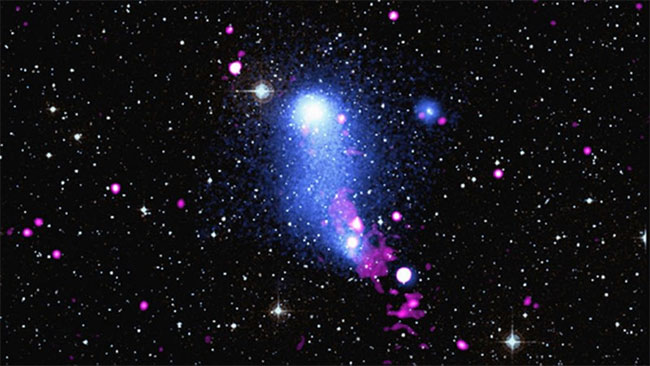Cosmic bridge between galaxies
The Abell 2384 system carries an obsession with dreary pasts. Several hundred million years ago, the two galaxies that formed this system collided with each other .
The result of this collision was an extraordinary space bridge, filled with hydrogen gas was formed, through which matter flows today.
Recent observations show that this cosmic bridge has been violently bombarded by particles in intergalactic space. These orbits are bent by a supermassive black hole. For astronomers, this unusual event opens up a new perspective on the evolution of galaxies.

Abell 2384 system.
Scientists have observed the unusual bridge based on the Giant Metrewave electromagnetic telescope in India, NASA's Chandra X-ray Space Observatory and ESA's XMM-Newton Observatory. The cause of this bridge is a supermassive black hole in the galaxy outside the southern galaxy cluster. This black hole has emitted two streams of particles moving in opposite directions. In it, a stream directed at the cosmic bridge.
The space bridge spans over 3 million light-years away and is about 6 trillion times the mass of our Sun, which is four times heavier than the Milky Way. The stream of black holes lasts about 1.2 million light-years.
Different types of interactions occur quite often between celestial bodies. Galaxies and clusters of galaxies are constantly connected. Astronomers call this phenomenon the 'cosmic accordion' - galaxies, galaxies and galaxies move through each other, extend the system, and then return to their original form. The phenomenon of galaxy clusters colliding with each other is not necessarily destructive collision. This phenomenon is often like two flocks of birds combined into one, rather than the event of a collision between cars.
However, that does not mean that individual galaxies are unaffected. Observations for the Abell 2384 system show that, in many spiral galaxies in the constellation of galaxies, star-forming processes no longer occur. That's because after interaction, twisted galaxies lose rare gases (inert gases) - the fuel for new star creation.
- Stunned disclosure of technology to identify cosmic galaxies
- Journey to search for 'invisible' galaxies in the universe
- 'The cosmic eye' emerged from the clash between the two galaxies
- The bridge of gas over 2.6 million light years
- Detecting the galaxy seems to not exist
- Impressive bridges in the world
- 13 beautiful fairy-like bridges worth admiring around the world
- The knot formed from two galaxies collided
- The bridge of architectural masterpieces of the world
- The bridge 'engraved, carved out' is like magic
- See the most beautiful bridges in Vietnam
- Top 10 most unique and unique
 Van Allen's belt and evidence that the Apollo 11 mission to the Moon was myth
Van Allen's belt and evidence that the Apollo 11 mission to the Moon was myth The levels of civilization in the universe (Kardashev scale)
The levels of civilization in the universe (Kardashev scale) Today Mars, the sun and the Earth are aligned
Today Mars, the sun and the Earth are aligned The Amazon owner announced a secret plan to build a space base for thousands of people
The Amazon owner announced a secret plan to build a space base for thousands of people